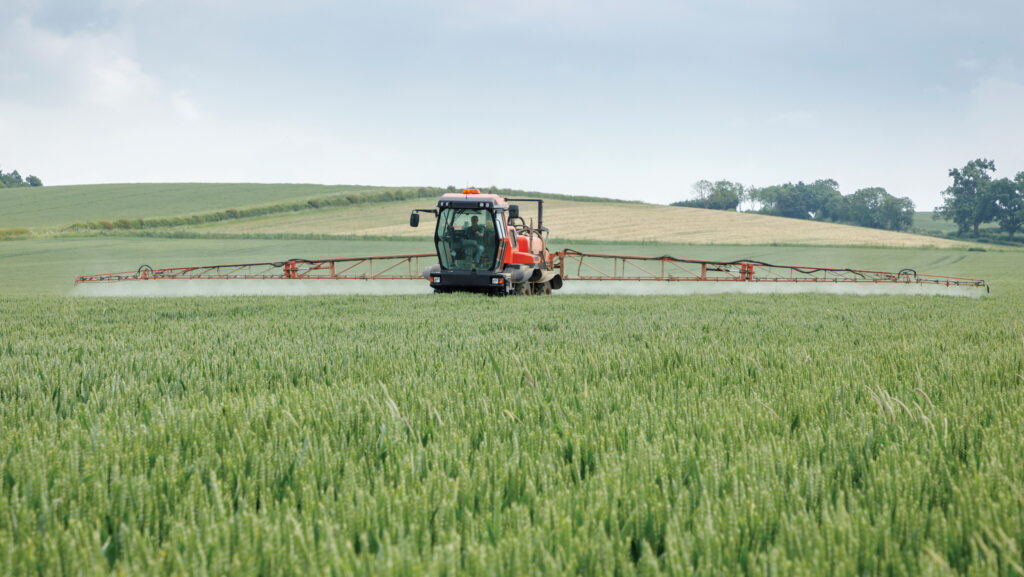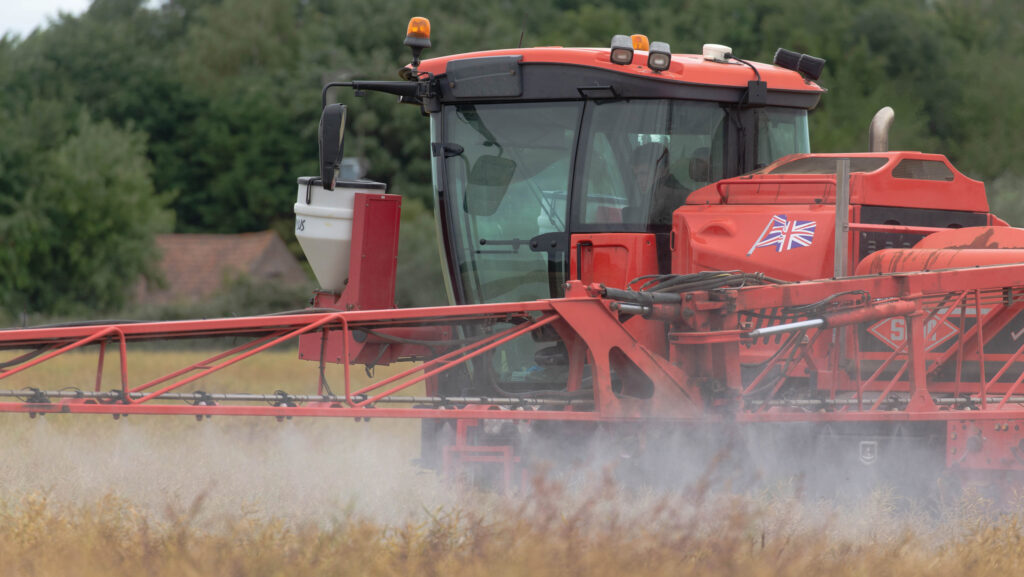Crop Watch: OSR pod sealants and foliar N in wheat
 © GNP
© GNP The weather remains unsettled with disease pressure staying high. For example, the showery weather as resulted in rhynchosporium starting to develop in spring barley crops in the west.
This changeable weather has also prompted agronomists to consider applying podstickers to oilseed rape crops in a bid to minimise seed losses, which proved substantial in some crops last summer.
See also: After 80 years, where next for Recommended List?
South
Tod Hunnisett
AICC (Sussex)
I mentioned in my last Crop Watch about how May might affect agronomists’ partners. June is where agronomists look at their own season. June can be as equally forgiving as it is unforgiving.
There are some amazing looking crops around. I just wish they were all under my watch. There are some equally awful looking crops around – I just wish some of them weren’t under my watch.
I’m sure I have as many amazing and awful crops as everyone else, but all in all I would say that after an unbelievably ghastly winter it has been a generally forgiving spring.
This cropping year has driven home to me the most important factor of arable farming. Getting stuff done at the right time is more important than anything else.
The difference between crops that had a well-timed pre- or early post-emergence herbicide, compared with those that tried to rely on spring weed control, is phenomenal.
A gap that has been too long between fungicide applications has made the difference between there being a leaf or not.
Once again, I give credit to the operators who have managed to get stuff done in a very difficult season.
Timing
I remember when I was at Writtle Agricultural College in the 1980s, my crop production lecturer (a man for whom I had the utmost respect) saying that timing was more important than product or rate.
After 40 or more years I can’t disagree with him.
By the time this goes to press some OSR crops will be ready for desiccation. Not long after that we’ll be looking at uncontrolled grassweeds being sprayed to make them combinable in cereal crops.
Then we have to sort out next year. Someone, at some stage, should make it known to the general population that glyphosate is probably the most important molecule in global food production.
East
Marion Self
AICC/Prime Agriculture (Suffolk)
The weather remains unsettled with only moderate temperatures and all too frequent showers. This is fuelling the rapid progression of many diseases.
In early drilled or dense wheat crops even robust, well timed fungicide programmes are struggling to keep the top yield building leaves clean.
All crops really need some sunshine now to slow the epidemic of wet weather diseases and to maximise yield potential and quality.
With fingers crossed, the weather forecast for the end of June and July looks more promising.
Disease development between wheat varieties (and also within the same variety) varies dramatically between drilling date; with early and thick late-drilled crops most at risk from extreme infections.
For this reason, it is important to note the epidemic in your own crops and to visit local trial sites to see how varieties are behaving elsewhere.
Always consider the disease infection in context of the region, drill date and density of the crop as well as fungicide treatment and timings.
Well timed treatments have performed significantly better in a season when the rainfall and warming conditions have caused aggressive septoria, yellow and brown rust infections to cycle quickly.
Disease pressure in barleys is also high with a prevalence of net blotch, brown rust and more recently ramularia, sometimes threatening to cause early senescence.
Trials data from this challenging season will be very interesting.
Apart from obvious differences in foliar disease levels, stem and root disease pressure (such as eyespot and take-all) is also high; although the impact of these diseases will largely be masked by the high moisture status of soils.
Milling wheats
For quality wheats, growers targeting a milling premium may be planning a final foliar nitrogen application at the watery to milky ripe stage.
To avoid scorching the crop it’s important to be careful to make these applications in cool, dull conditions.
During grain fill also monitor crops for aphids on the ear, but only treat if close to guideline thresholds as advised by AHDB. We haven’t had to treat for many years now.
In pulses, pea aphid and black bean aphid are at relatively low levels, but established populations will increase rapidly as temperatures rise.
Again, applications should only be made when populations reach threshold.
For peas treatment should be considered when 15% of plants are infested at early flowering. Remember to check product labels for the maximum number of applications per crop and harvest interval.
For instance pirimicarb (Aphox) can only be applied once at maximum label dose in 280g/ha and has a seven day harvest interval for vining peas.
Most sugar beet crops are now covering the ground and weed control is complete. Weeds have been tricky this season in fast growing soft crops.
In the last few weeks many later drilled crops or those on lighter soils have suffered stress shown by yellowing symptoms.
Also, reddening and poor growth may be associated with acidity and is worth checking out. Beet respond well to plenty of foliar nutrition.
West
Antony Wade
Hillhampton Technical Services (Hereford/Shropshire)
Spring cereals have enjoyed the recent showery weather. Most of mine are strong and thick so have had one and in some cases a second plant growth regulator dose with T1 fungicides.
The downside to the showery weather is that rhynchosporium is starting to develop in spring barley crops.
Flag leaves are emerging on these crops so T2 recommendations will be out by the time this article is published.
Spring bean crops have come through the early pea and bean weevil notching without the need for any insecticide.
Chocolate spot is slow to develop so far more prevalent and developing recently so these will be getting early flower fungicide and phosphite protection.
In contrast to last season, chocolate spot in winter beans has been very slow to develop and is being held by an early flower azoxystrobin.
Rust is just starting to break out so these will be getting a late flowering spray of benzovindiflupyr + prothioconazole.
These crops, which looked distinctly marginal at the turn of the year, now look very promising with good pod set down the whole of the plant, which is not always the case.
Maize emerged well from good seed-beds and pre-emergence herbicides have done a good job, so much post-emergence herbicide has yet to be applied.
The recent weather with an unseasonably cold north wind with cold nights has caused crops to suffer a bit so I will probably wait until crops recover before applying any post-emergence herbicide.
Oilseed rape
Many winter oilseed rape crops are not looking very pleasing on the eye with open crops which never got the chance to fill out due to the prolonged wet weather which continued into April when it started flowering.
Weeds have now filled these gaps.
This season has not helped the cause for keeping this crop in the rotation, but finding a consistent break crop option is not obvious.
How many growers will take the gamble again this autumn will all depend on how willing they are to take the risk. I could certainly do without the autumn angst.
The continued regular rainfall events have certainly kept up the septoria pressure whilst the mid-September/early-October drilled wheat fields are even, which is a rarity this season, but the most robust fungicide strategies utilising new chemistry are struggling to keep the septoria under control.
We have infection on Leaf 2 and 3 with lower leaves already lost. There have been many reports of significant yellow and brown rust pressure, but for my area which is renowned for septoria this is the disease that will make or break crop output this season.
Later drillings are significantly cleaner with septoria, but many are patchy and shy of optimum ear numbers.
T3s in the earlier drillings have tried to top up septoria protection in the vain hope of retaining as much green leaf duration for as long as possible.
Later drillings have been more focused on rust and fusarium protection.
Winter barley crops are starting to turn despite limited sunny hot days. Fungicide programmes have done a good job, but there is some late season disease coming in on the upper leaves.
As we pass through the summer solstice and longest day we need these longer days of light to be exactly that –maximum hours of sunlight and warmth so the crops can convert that energy into sugars in the form of grain/seed filling.
North
Conor Campbell
Hutchinsons (Northumberland)
So, I may have got too excited in my last column and let the sunshine go to my head. Since then, we have had 100mm of rain and some very windy days.
Ironically, the wind has really dried to top few inches of soil out in the past week, so the recent showers may well be needed.
We managed to run our variety trials event without getting wet and the support is always greatly appreciated, especially as it was the best spray day for about three weeks.
The general consensus on the day was how yellow spring barleys and even wheats looked, as folks travelled from all over Northumberland and the Scottish Borders to our trial site.
The rain landed right as we looked to apply our T2 fungicides. These inevitably became T2.5 sprays for the most part despite everyone’s best efforts.
Septoria pressure really ramped up with the wet weather and this is evident in the weaker varieties.

© Tim Scrivener
T3 spray
The temptation is to skip a T3, but with more wet weather forecast, this would be a false economy. We still need to keep disease low in the crop as well as protect the ears.
The wet weather will promote further disease pressure so a prothioconazole- and tebuconazole-based T3 should be considered. I am also considering a strobilurin on the better crops.
Winter barleys look clean, but the untreated plots highlighted the importance of disease control this spring.
Ramularia type symptoms are starting to show and, given the stress these crops have been under, it comes as no surprise.
With unpredictable weather, an early pod sealant on oilseed rape could be a good move this year.
Spring crops in general are struggling with the changeable weather. Established in challenging conditions, they seemed to come through well, but have then been faced with a lot of wet weather.
The wind has dried the top few inches, where they are mostly rooted, meaning they could do with a bit of moisture.
I am being kind to them where I can and focusing on nutrition to keep them moving, as they will come right.

